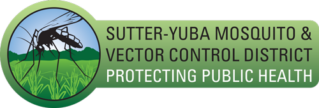Predatory Fish
Mosquitofish

The mosquitofish, Gambusia affinis, a live-bearing American fish, is utilized as a predator of mosquito larvae in many diverse aquatic habitats around the world. Full grown females reach lengths of up to 2.5 inches and males up to 1.5 inches. The female gives birth to live free swimming offspring. Their gestation period is variable ranging from 18 to 35 days. They can produce broods ranging between 10 – 300 young. Mosquito Control Technicians stock these larvae eating fish in California without the need of a permit.
Guppy

The guppy, Poecilia reticulata, is a live bearing fish native to coastal Venezuela, northern Brazil, Guyana and the Caribbean islands. They were first introduced into the United States in 1912. Guppies are noticeably smaller than mosquitofish. Females reach lengths of 1.9 inches and males 1.1 inches. Males are more ornate displaying iridescent splotches of red, orange, green, blue and black. In addition to their popularity as pets, guppies have proven to be useful predators of mosquito larvae. They have the ability to withstand levels of chemical and organic pollutants that would cause fatalities in most fishes and are sometimes successfully employed in harsh environments where even the tolerant mosquitofish can’t survive. Guppies are more sensitive to extreme water temperatures than are mosquitofish. They tolerate a range between 52°F and 100°F, but prefer water temperatures around 80°F. Winter water temperatures in northern California get below 52°F making survival impossible without providing temperature protected environments for guppy populations. Guppies are useful in mosquito control, but require transportation and stocking permits approved by the Dept. of Fish and Game.
Predatory Insects
Backswimmer

Aquatic insects that belong to the family Notonectidae are commonly referred to as Notonectids or backswimmers. California has two genera, Buenoa and Notonecta. Adult notonectids are long slender insects that vary from 1/2” to 3/4” in length. The head has two large eyes and its two legs are long and oar-like. Coloration varies from black with white to reds, red-oranges, grays and browns. One behavioral characteristic that distinguishes notonectids from other aquatic insects is their habit of swimming on their backs. They are found from sea-level to 9,000 feet in the Sierra Nevada mountains.
Hunting by sight, nymphs and adults are voracious predators on mosquito larvae and other similarly sized aquatic organisms. Notonectids grasp their prey with their legs and then extract the prey’s body fluids with their piercing-sucking mouthparts. In some mosquito control programs, notonectid eggs are collected on artificial oviposition sites and then relocated to known mosquito sources, augmenting other control measures.
Water Scavenger Beetle
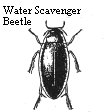
Water scavenger beetles belong to the insect order Coleoptera, family Hydrophilidae. In California, there are 16 genera that contain 63 species. They range in size from about 1/8” to about 2 inches. A few species are actually terrestrial, living in moist soil or dung. Hydrophilids have 4 distinct life stages: egg, larva, pupa and adult. Aquatic hydrophilid larvae are recognized as beneficial organisms in regard to mosquito larvae control. Depending on species, hydrophilid larvae are either predaceous or herbaceous. Predatory species seize their prey and crush them with their mandibles. They can either ingest the body fluids or eat solid tissue. Adults can fly and are often attracted to lights at night.
Giant Water Bug
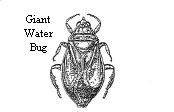
Giant water bugs belong to the insect order Hemiptera, family Belostomatidae. Other descriptive common names include the “electric light bug” for their habit of swarming around electric lights, and the “toe biter” for the painful bite they can deliver. In California, there are three belostomatid genera, and 6 different species. Adult belostomatids are large brownish flat insects. Two large compound eyes protrude from its head. They grow to lengths of 2 inches. Belostomatids have 3 life stages: egg, nymph and adult.
Adults are effective predators of small aquatic insects, including mosquito larvae, snails, tadpoles and even small fishes. After catching their prey with their forelegs, they subdue it with a paralyzing toxin injected by its beak. Potent enzymes in the injected saliva liquefy the prey’s internal organs, making it possible for the belostomatid to suck it’s victim dry. Some belostomatids have unusual defense mechanisms. When handled, most can expel a foul smelling fluid from their anus, which can be sprayed three to four feet. Another mechanism is called “death feigning”. When removed from the water, some species can maintain a rigid posture for a considerable length of time, fooling potential predators.
Dragonfly Naiad
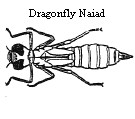
Dragonflies belong to the order Odonata, suborder Anisoptera. Sixty-three species have been identified in California. Immature dragonflies, called naiads, are completely different in appearance from the adult form. They are long insects with a large head, compound eyes and six spindly legs. Naiad mouth parts are designed to be able to thrust forward and seize prey. Fully extended they total about 1/3rd of the insects body length. Species vary in length from 1/4” to 3 inches and range in color from gray to green to brown. Dragonfly naiads feed on almost any kind of aquatic animal. Prey is caught by its extendable mouthparts. Some species stalk their prey while others wait for their next meal to come by.
Damselfly Naiad
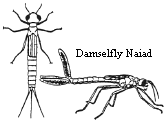
Damselflies belong to the order Odonata, suborder Zygoptera. Damselfly naiads are often mistaken for dragonfly naiads. They have similar looks, mouthparts and stalking characteristics and are important predators of early instar mosquito larvae. Their other differences are not important enough to discuss here.
